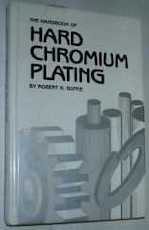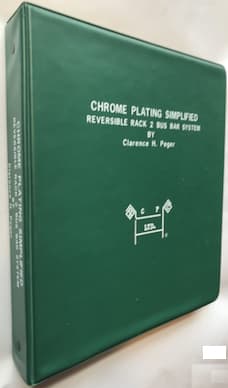
Curated with aloha by
Ted Mooney, P.E. RET

The authoritative public forum
for Metal Finishing 1989-2025

-----
Heating and Cooling of Chrome Plating Tanks
April 28, 2022
RFQ: We need offer for cooling system of hard chrome bath.
Please see data I have:
Tank 3000 l
Solution concentration 240 g/l
Operating temperature: 50 - 60 °C
Amperage: 2800 A
Operating time: 5 hours
Solution maximum temperature 80 °C
Engineer - Aracariguama - SP Brazil
privately respond to this RFQ
Ed. note: As always, gentle readers: technical replies in public and commercial replies in private please (huh? why?)
⇩ Related postings, oldest first ⇩
by Robert K. Guffie

on AbeBooks
(rarely)
or eBay
(rarely)
or Amazon
(affil links)
Q. Dear Reader,
I am a worker in an electroplating Shop. Recently we are planning to purchase cooling systems for chrome plating tanks. We need information about cooling equipment. Presently on large sized parts, with high current densities the tanks heats up even when the if the heaters are tripped off. The solution temperature rises and solution boils. Hence at higher currents the tanks need to be cooled rather than heated. I would appreciate guidance from you
Thanking you in anticipation.
Najeeb
Muhammad Najeeb- Karachi, Pakistan
2000
A. Dear Mr. Najeeb,
As a hardchrome plating company with many years of experience, we feel that we might be able to help you. There are many different solutions for your problem, but in order to be able to help you, we would like to receive more detailed information, such as:
Tank size,
catalyst condition (density, Fe, Cr3+, etc.)
Rectifier capacity
If you give us this information, we will work out a detailed plan for you.
Kind regards,
Roel Jaarsma- Hengelo The Netherlands
2000
A. Hi Nageeb,
I guess that you have 3 options: 1. Use a much larger tank; 2. Use a cooling coil (PVDF should be ideal) which is the normal approach, I believe; 3. Use what I call 'evaporative control'.
Back in 1980 I encountered exactly the same problem. The customer in Vancouver, EBCO, was plating very large diameter rolls and the heat became excessive which, possibly (I am not a plater!) might lead to a poor finish.
EBCO still have this system. However, at that time in 1980 they wanted to do something about the air pollution, too.
That's where I came in. I suggested what I call an ordinary 12 micron chromic 'dry scrubber' mist eliminator (fairly sophisticated internal design!) which has two banks of PVC blades. I suggested (but I had never every heard of this being done before) that the eliminator would have the second blade bank separated and with its own washdown bank ... and that they use a pump to spray the first blade bank with the hot chrome. (I have over 300,000 cfm of hard chrome scrubbing fully annotated).
What happens then is that the ambient air (Boyle's law?) draws off the heat from the tank's hot liquid which is returned, definitely cooler!, via gravity back to the tank.
If you wanted to corroborate this, let me know and I could give you the address & contact at EBCO. OK? Last year they did replace one of the blade banks -- not bad for 20 years service)
Cheers!

Freeman Newton [deceased]
(It is our sad duty to advise that Freeman passed away
April 21, 2012. R.I.P. old friend).
Chrome plating tank heating/mixing
by Clarence H. Peger
(You're unlikely to find this for sale ... but copies are in select libraries)

from AbeBooks
* rarely available *
or eBay
* rarely available *
or
Amazon
* rarely available *
(affil links)
Q. Hi, I am working on chromium plating for my thesis. I have a question regarding air sparging in hard chrome plating. Is it mandatory to sparge air? If yes, what is it for - mixing or heat removal? Or on the other hand, is the typical plating load enough to maintain the temperature of the plating tank or external heater is needed to maintain the temp?
Susheel YadavUniversity of Cincinnati - Cincinnati, Ohio
2000
A. Best practice is certainly to include heating because the bath operates at 110 to 140 °F. (depending on exactly what you are doing) and you do not want to use your rectifier and your chrome plating solution as a heater. Best practice is also to include cooling coils. The air would be used for solution mixing rather than cooling, particularly if the tank is deep.

Ted Mooney, P.E.
Striving to live Aloha
finishing.com - Pine Beach, New Jersey
2000
Q. Hello!
Someone has told me that the chrome bath is heated during plating time. So after each plating process it has to be cooled back down to 45 °C. Is this correct or not?
Thanks for any answers!
- Bovec, Slovenia
October 9, 2014
A. Hi Bojan. You are trying to operate the chrome plating tank at 45 °C, so you must do what is necessary to keep it at 45 °C. That means providing heat if the bath falls below 45 °C, and removing heat (providing cooling) if the bath exceeds 45 °C ...
If the bath runs 24 hours a day, and it processes a reasonable amount of production, it is possible that separate heating provision may not be required because the rectifier will provide more than enough heat (but it's still desirable). If the bath operates frequently or constantly, it will probably be necessary to remove heat with cooling coils, or the tank will overheat. Stopping production to let the tank cool off is rarely a satisfactory answer. Good luck.
Regards,

Ted Mooney, P.E.
Striving to live Aloha
finishing.com - Pine Beach, New Jersey
October 2014
Q. Thanks for your answer. The chromium baths does not heated during plating time because of chemical reactions if I'm correct?
In my opinion that man was wrong, when he said that when the electric current goes through chromium electrolyte and the reactions takes place the bath get heated and it's necessary to cool it down to 45 °C. He is not a chemist and he doesn't know much about this, but he has much more experience then me so I wanted to get opinion from someone else also.
I was measuring the temp. in chromium baths now for 3 days and the temp. is constant from 42 °C to 46 °C. -- but about half a meter deeper the temp drops to 40-41 °C. Can this cause a burned or dull deposit if the temperature is below 42?
- Bovec, Slovenia
October 16, 2014
A. Hi. The temperature must be constant while you are plating: all the time and at every depth.
It is not true that having the heating on while plating will necessarily cause a problem. But it is true that the plating generates so much heat that additional heating may not be required during that time, and cooling may be required to keep the temperature from climbing. If you multiply the plating Amps you are using times the plating Volts you are using, you know the Watts of heat you are adding to the bath.
A range of 42 - 46 °C is too much variation. I think you should not exceed the range of 43-44 °C for the most consistent plating. You probably have insufficient sparging/agitation if the temperature is lower down deeper in the tank. Good luck.
Regards,

Ted Mooney, P.E.
Striving to live Aloha
finishing.com - Pine Beach, New Jersey
October 2014
Heat produced during plating hard chrome
Q. I have 1000 Ltr hard chrome plating solution , operated with 1000 Amp Rectifier. it will work 24 x 7. I want to cool the tank, what will be amount of heat generated during the process. Is there any thumb rule for knowing the temp increase / inch2 /ampere?
Jagdish kshop employee - ujain /india
July 28, 2018
A. Hi Jagdish. The thumb rule is that all of the power introduced to the tank will be converted to heat, and all of it must be removed. That means you multiply Amps x Volts to arrive at the Watts of heat you are inputting, and convert this to BTUs/hour (multiply it by 3.41) or Calories/hour (multiply by 859.8) which must be removed.
If the bath operates at 130 °F (54.4 °C), you can estimate the heat lost from the walls and surface of the tank and deduct this from the cooling requirement. Good luck.
Regards,

Ted Mooney, P.E. RET
Striving to live Aloha
finishing.com - Pine Beach, New Jersey
July 2018
Hex Chrome Plating Bath not maintaining temperature
Q. Hello,
For approximately a month now I have not been able to maintain my temperature of 140 °F in my Hex Chrome bath. My first thought was to check the cooling system in place due to the inefficiencies of Chrome plating but found everything to be in order (went as far as checking if an unintentional thermosiphon had developed). I have also checked all steam heat components leading form the boiler to the steam coils themselves (again no luck). The only adjustment made prior to this issue is the change in agitation depth (up 8"). Could this change be causing my temperature issue? Have any of you come across an issue similar to this in the past?
Plating Engineer - Moline, Illinois USA
November 11, 2019
A. Hi Garrett. It is isn't clear to me whether you are saying that the tank is getting too hot or not staying hot enough. Sorry, I also don't know quite what you mean by agitation depth -- are you referring to mechanical vertical agitation during plating, or something to do with the air agitation coils at the bottom of the tank? 140 °F is more typical of hard chrome plating than decorative plating, so I assume that's what you are doing.
Obviously the rectifiers add a great deal of heat to the tank, especially in hard chrome plating.
Regards,

Ted Mooney, P.E. RET
Striving to live Aloha
finishing.com - Pine Beach, New Jersey
November 2019
Q. Hey, I'd like your input on keeping a chrome tank cool when battling barium buildup. We have two sizable coils in the tank (poly) and they are more than capable of keeping up, but once the barium sulphate precipitate cakes them up we have significant issues and it's quite difficult to remove. Elimination of the barium is not an option, and we've reduced it as much as possible. We don't want to run a filter on the tank due to concerns of a significant leak and loss of solution for safety and environmental concerns. My question would be if there is any way to cool the tank which I may not have heard if that wouldn't take up too much space? Really any thoughts appreciated.
Thanks,
- Kentucky
April 13, 2022
A. If you can't get to the root cause for the excess sulphate, then consider making the barium adds in an auxiliary tank instead of in the plating tank. Then, filter the chrome solution back to the plating tank. You wouldn't need to move the entire solution to the auxiliary tank, just move enough to take the sulphate near to zero for a calculated portion that, when returned, gets your sulphate back to the proper ratio.

Jon Barrows, MSF, EHSSC
Independence, Missouri
April 14, 2022
Q, A, or Comment on THIS thread -or- Start a NEW Thread

